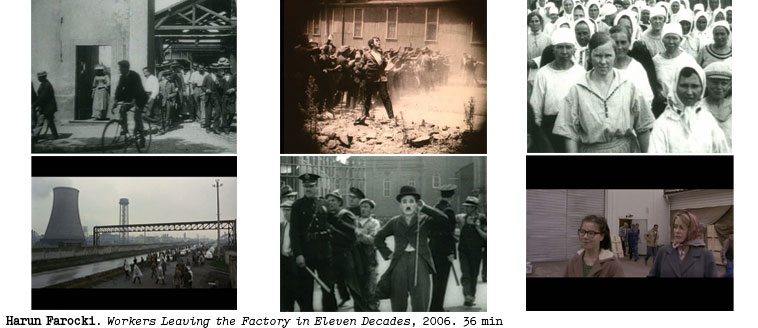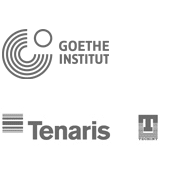Obras
Eye / Machine II, 2002. 15 min.
How can the distinction between "man" and "machine" still be made given today's technology? In modern weapons technology the categories are on the move: intelligence is no longer limited to humans. In Eye / Machine II Farocki has brought together visual material from both military and civilian sectors, showing machines operating intelligently and what it is they see when working on the basis of image processing programs. The traditional man-machine distinction becomes reduced to "eye/machine", where cameras are implanted into the machines as eyes.As a result of the Gulf War, the technology of warfare came to provide an innovative impulse which boosted the development of civilian production. Farocki shows us computer simulated images looking like something out of science-fiction films: rockets steer towards islands set in a shining sea; apartment blocks are blown up; fighter aircraft fire at one another with rockets and defend themselves with virtual flares … These computer battlefields - will they suffice or shall we need further rationalization drives for new wars? Eye / Machine II is the continuation of a wider examination of the same subject: Intelligent machines and intelligent weapons. As an installation the work is presented on two monitors or as a double projection. In this, the single-channel version, the two image tracks are shown simultaneously on one screen.
Antje Ehmann
-
Eye / Machine II, 2002
Video, col. and b/w, single-channel-version, 15 min.
Directo, scriptwriter: Harun Farocki with Matthias Rajmann, Ingo Kratisch, Kilian Hirt / Editor: Max Reimann / With support from ZDF/3sat, Mainz, (Inge Classen), Galerie Greene Naftali, New York (Carol Greene), and Brugge 2002, European Capital of Culture/ desire productions, Cis Bierinckx / Producer: Harun Farock
Workers Leaving the Factory in Eleven Decades, 2006. 36 min
The installation of scenes from throughout film's history of workers leaving the factory, is displayed on twelve monitors simultaneously. In cinematography, perception and concept diverge. Indeed history's first film, Lumière's La sortie des usines Lumière, shows a building that doesn't look like a factory at all. It looks more like a farm. When it comes to social conflict, the show place "in front of a factory", is very significant; when it comes to a private life of a film's character, which really only begins after work, the factory is relegated to the background. In Fritz Lang’s Clash by Night (1952), one sees Marilyn Monroe on the assembly line, coming out of the factory, and one hears her talking about it. But the existence of factories and movie stars are not compatible. A movie star working in a factory evokes associations of a fairy tale in which a princess must work before she attains her true calling. Factories - and the whole subject of labor – are at the fringes of film history.
Harun Farocki
-
Workers Leaving the Factory in Eleven Decades, 2006
Video installation for 12 monitors. Video b/w and col., sound, 36 min. (loop)
Idea, realization: Harun Farocki / Collaborator: Jan Ralske
Serious Games III: Immersion, 2009. 20 min
For the video installation Immersion Farocki visited a workshop organised by the Institute for Creative Technologies, a research centre for virtual reality and computer-simulations. One of their projects concerns the development of a therapy for war-veterans suffering from Posttraumatic Stress Disorder. Farocki is interested in the use of virtual realities and games in the recruting, training and now also therapy for soldiers. Farocki explores the connection between virtual reality and the military – how the fictional scenarios of computer games are used both in the training of U.S. troops prior to their deployment in combat zones, and in psychological care for troops suffering battlefield trauma upon their return.
-
Serious Games III: Immersion, 2009
2 videos, col., sound, 20 min. (loop)
Director, scriptwriter: Harun Farocki / Research: Matthias Rajmann / Editor: Harun Farocki, Max Reimann / Cinematographer: Ingo Kratisch / Sound: Matthias Rajmann / Production: Harun Farocki Filmproduktion, Berlin, with support from Medienboard Berlin-Brandenburg GmbH / Co-production: Jeu de Paume, Paris, Stuk, Leuven
The Silver and the Cross, 2010. 17 min
The work examines the painting Depiction of the Cerro Rico and the Imperial City of Potosí (Oil on canvas, 262 x 181 cm) by Gaspar Miguel des Berrío, 1758, in the Museo Colonial Charcas de la Universidad San Francisco Xavier, Sucre, Bolivia.
-
The Silver and the Cross, 2010
2 videos, col., sound, 17 min.
Concept and realization: Harun Farocki / Image: Ingo Kratisch / Editing: Christine Niehoff / Postproduction, management, sound: Matthias Rajmann / Narration: Cynthia Beatt / Translation: Michael Turnbull / Production: Harun Farocki Filmproduktion, Berlin
Produced for the exhibition “The Potosi Principle”, curated by Alice Creischer, Max Jorge Hinderer and Andreas Siekmann. Venues: Museo Nacional Centro de Arte Reina Sofía, Madrid; Haus der Kulturen der Welt, Berlin; Museo Nacional de Arte and Museo Nacional de Etnografía y Folklore, La Paz
Parallel, 2012. 17 min
In this new work, Farocki juxtaposes the history of computerbased animation with elements of art history. In only thirty years, computer-generated images and animations have evolved from simple symbolic forms into images that aspire to perfect simulation, and seem to desire to outperform cinematographic and photographic representations, not merely of “static” reality, but increasingly of the dynamic aspects of life, as manifest in gestures or complex movement in general. In appropriating the dynamics of social and natural reality, does computergenerated hyperrealism seek to outdo reality itself?
Today, mimesis has become a matter of generative algorithms, and the resulting technologies are increasingly capable of calculating, predicting, and controlling complex processes—from manufacturing, to war, to emotional experiences in the animated worlds of mass entertainment. Underlying Farocki’s investigation into the frontiers of innovation in current image-technologies is the assumption that increasingly, we live in technologically produced image-worlds in which images have become what he calls “idealtypical.” In the new mimetic paradigm of digital “realism”, reality is no longer the measure of the always imperfect image; instead, the virtual image increasingly becomes the measure of an always-imperfect actuality. With the “ideal-typical” image, representation seeks to overcome lived reality by constructing, monitoring, and governing it. Even fantasy and fiction now tend to assume a predictive and even preventive quality. Does this leave actual, lived reality to exist only as derivation of the ideal, as flaw or impurity, or, like in military or surveillance technologies, as a potential threat? Have these idealtypes become our new normative schemes, all-encompassing idols capable of scripting and predicting all actual life-movement?
One more time, Parallel questions the notion of “progress” that underlies histories of art and representation based on a linear, evolutionary progression from imperfect representation (mimesis) to more accurate, complex, and perfect forms. Parallel is like an interrogation of possible other stories, evolutions, or reverse-evolutions of which the image-surfaces of digital animation and their underlying generative algorithms speak.
Anselm Franke
(Excerpt from the catalog Modern Monsters / Death and Life of Fiction, Taipei Biennial 2012. Taipei: Taipei Fine Arts Museum)
-
Parallel, 2012
Video installation. 2-channels video HD. Col., sound, 17 min.

